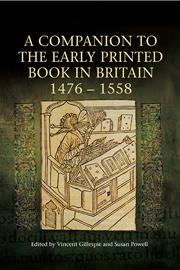Book contents
- Frontmatter
- Contents
- List of Illustrations
- List of Contributors
- Preface
- Acknowledgements
- Abbreviations
- Chronology of the Period
- Introduction
- I THE PRINTED BOOK TRADE
- II THE PRINTED BOOK AS ARTEFACT
- III PATRONS, PURCHASERS AND PRODUCTS
- 7 Merchants
- 8 The Laity
- 9 The Secular Clergy
- 10 The Regular Clergy
- 11 Universities, Colleges and Chantries
- IV THE CULTURAL CAPITAL OF PRINT
- Index of Manuscripts
- Index of Printed Books
- General Index
10 - The Regular Clergy
from III - PATRONS, PURCHASERS AND PRODUCTS
Published online by Cambridge University Press: 05 April 2014
- Frontmatter
- Contents
- List of Illustrations
- List of Contributors
- Preface
- Acknowledgements
- Abbreviations
- Chronology of the Period
- Introduction
- I THE PRINTED BOOK TRADE
- II THE PRINTED BOOK AS ARTEFACT
- III PATRONS, PURCHASERS AND PRODUCTS
- 7 Merchants
- 8 The Laity
- 9 The Secular Clergy
- 10 The Regular Clergy
- 11 Universities, Colleges and Chantries
- IV THE CULTURAL CAPITAL OF PRINT
- Index of Manuscripts
- Index of Printed Books
- General Index
Summary
The regular clergy were patrons of the printing revolution, converts to radical change at the cornerstone of the establishment. From the faint, fragmented testimony of the first, pioneering workshops, modern research has succeeded in focusing the critical contribution of the religious orders, mendicant and (perhaps especially) monastic: we now know that from Mainz, outward, through the Rhineland (Augsburg, Freiburg, Marienthal, Speyer and Basel), north and westward into the Netherlands (Brussels, Gouda, Hem, Rostock) and south of the Alps as far as Rome (Subiaco), the regulars represented more than the buyers, and occasional, benign sponsors, of the early printed book; they may also be counted among the early entrepreneurs of the press, exploiting, and perhaps, to a degree, directing the diaspora of German craftsmen, and even the practitioners – male and female religious alike – of what its first audience celebrated as the ‘magical art’.
This is, or has become, a story of Continental Europe. The large and culturally influential constituency of regular clergy has been left at the margins of accounts of the reception of printing in England. At first, of course, there was no compulsion for scholars to look for the traces of print culture in the English cloisters given the prevailing view that their traditions of book-learning had been forgotten long before the 42-line Bible was first seen at Frankfurt.
- Type
- Chapter
- Information
- A Companion to the Early Printed Book in Britain, 1476-1558 , pp. 176 - 206Publisher: Boydell & BrewerPrint publication year: 2014

